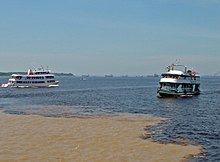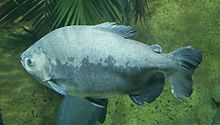Whitewater river (river type)

A whitewater river is classified based on its chemistry,
The best-known whitewater rivers are Amazonian and have their source in the Andes, but there are also whitewater rivers elsewhere in South America and in other continents.[1][4][5][6]
Amazonian rivers fall into three main categories: whitewater, blackwater and clearwater. This classification system was first proposed by Alfred Russel Wallace in 1853 based on water colour, but the types were more clearly defined according to chemistry and physics by Harald Sioli from the 1950s to the 1980s.[7][8][9] Although many Amazonian rivers fall clearly into one of these categories, others show a mix of characteristics and may vary depending on season and flood levels.[8][10]
Location
In South America

The best-known whitewater rivers are Amazonian and have their source in the Andes. The main whitewater rivers are Solimões–Amazon, Caquetá–Japurá, Putumayo, Marañón, Ucayali, Javary, Juruá, Acre, Purus, Madre de Dios, and Madeira.[8] Although the Branco River traditionally is considered whitewater,[11][12] it has a number of characteristics (some of them varying with season) that do not fit clearly into the classification and some refer to it as clearwater.[13]
Outside the Amazon, a small number of South American rivers are considered whitewater, most notably certain tributaries of the Orinoco such as the Guaviare, Meta and Apure Rivers, and of the Paraná—Paraguay such as the Bermejo and Salado Rivers, which have their source in the Andes.[4][5][14][15][16]
In other continents
Outside South America, this system of classification is not widely used, but there are several rivers with mainly whitewater characteristics. In Africa, these include the
Chemistry and sediments

In South America, most whitewater rivers originate in the Andes where they collect high levels of nutrient-rich sediments, notably
In some parts of the Amazon where the rivers are not naturally whitewater, "pseudo-whitewater" exists because of soil erosion from human activities.[3]
| Juruá River (typical whitewater) | Tapajós River (typical clearwater)
|
Tefé River (typical blackwater) | |
|---|---|---|---|
| pH | 7.27 | 6.56 | 5.03 |
Electric conductivity (μS/cm)
|
191.14 | 14.33 | 7.36 |
| Total suspended solids (mg/L) | 51.42 | 10.56 | 7.90 |
| Ca (mg/L) | 32.55 | 0.52 | 0.71 |
| Mg (mg/L) | 4.42 | 0.26 | 0.22 |
Na (mg/L)
|
10.19 | 1.50 | 0.40 |
K (mg/L)
|
1.98 | 0.93 | 1.41 |
| Total P (mg/L) | 0.080 | 0.010 | 0.033 |
| CO 3 (mg/L) |
106.14 | 8.80 | 6.86 |
| NO 3 (mg/L) |
0.031 | 0.040 | 0.014 |
| NH 4 (mg/L) |
0.062 | 0.19 | 0.13 |
| Total N (mg/L) | 0.39 | 0.35 | 0.24 |
| SO 4 (mg/L) |
2.56 | 0.30 | 4.20 |
| Colour (mg/Pt/L) | 41.61 | 4.02 | 54.90 |
| Si (mg/L) | 5.78 | 5.25 | 0.33 |
| Cl (mg/L) | 4.75 | 0.53 | 0.85 |
Ecology

The difference in chemistry and visibility between the various black, white and clearwater rivers result in distinct differences in flora and fauna.[7] Although there is considerable overlap in the fauna found in the different river types, there are also many species found only in one of them.[24][25][26] Many blackwater and clearwater species are restricted to relatively small parts of the Amazon, as different blackwater and clearwater systems are separated (and therefore isolated) by large whitewater sections.[7][25] These "barriers" are considered a main force in allopatric speciation in the Amazon basin.[7]
As in South America, distinct differences between species in black- and whitewater can be seen in Asia and Africa. For example, the fish fauna in African whitewater rivers tend to be dominated by
The high nutrient levels in whitewater rivers allow high levels of
The major seasonal Amazonian floodplains known as
| Animal groups present | Blackwater | Mixed water | Whitewater |
|---|---|---|---|
| Rotifera | 284 | 23 | 0 |
Cladocera
|
5 | 29 | 43 |
| Ostracoda | 39 | 97 | 29 |
| Calanoida | 11 | 51 | 66 |
| Cyclopoida | 22 | 49 | 61 |
| Chironomidae | 0 | 3 | 3 |
Acari (mites)
|
0 | 0 | 2 |
| Blackwater | Mixed water | Whitewater | ||||
|---|---|---|---|---|---|---|
| Animal groups present | Open water | Forest | Open water | Forest | Open water | Forest |
| Volvocaceae | 42 | 38 | ||||
| Rotifera | 87 | 5 | 34 | |||
Cladocera
|
6 | 5 | 8 | 1 | ||
| Ostracoda | 2 | 11 | 3 | 7 | ||
| Calanoida | 23 | 3 | 10 | |||
| Cyclopoida | 5 | 27 | 19 | 1 | 13 | 1 |
| Mysidacea | 1 | |||||
Diptera
|
1 | |||||
Acari (mites)
|
1 | 1 | ||||
| Larval fish | 1 | 1 | ||||
References
- ^ ISBN 978-1841621739.
- ^ S2CID 30470801.
- ^ S2CID 83788515.
- ^ .
- ^ a b Padisák, J.; C.S. Reynolds; U. Sommer (1993), Intermediate Disturbance Hypothesis in Phytoplankton Ecology: Proceedings of the 8th Workshop of the International Association of Phytoplankton Taxonomy and Ecology held in Baja (Hungary), 5–15 July 1991, Springer Science & Business Media, p. 118
- ^ ISBN 978-0-12-088449-0.
- ^ a b c d Duncan, W.P.; M.N. Fernandes (2010). "Physicochemical characterization of the white, black, and clearwater rivers of the Amazon Basin and its implications on the distribution of freshwater stingrays (Chondrichthyes, Potamotrygonidae)". PanamJAS. 5 (3): 454–464.
- ^ a b c d e f g Ríos-Villamizar, E.A.; M.T.F. Piedade; J.G. da Costa; J.M. Adeney; J. Junk (2013). "Chemistry of different Amazonian water types for river classification: A preliminary review".
- ^ ISBN 978-94-009-6544-7.
- ^ .
- .
- ISBN 978-0-12350-445-6.
- ^ de Souza kodra, A.; M.N. Fernandes; W.L. Paxiúba Duncan (2014). "Effect of clearwater on osmoregulation of cururu ray, Potamotrygon sp. (Chondrichthes; Potamotrogonidae), an endemic species from blackwater river". Scientia Amazonia. 3 (1): 15–24.
- ^ Petry, P.; J. Hales (2002). "Orinoco Llanos". Freshwater Ecoregions of the World.
- S2CID 189775082.
- .
- ISBN 1-55963-365-4.
- ISBN 978-2-8317-1326-7.
- ^ Baird, I.G.; B. Phylavanh; B. Vongsenesouk; K. Xaiyamanivong (2001). "The ecology and conservation of the smallscale croaker Bosemania microlepis (Bleeker 1858-59) in the mainstream Mekong River, Southern Laos". Nat. Hist. Bull. Siam Soc. 49: 161–176.
- ISBN 978-3-319-14354-5.
- ^ doi:10.1641/B580408.
- ^ "Waters". Amazon Waters. 28 May 2014. Retrieved 30 December 2016.
- ^ "Whitewater Rivers". Amazon Waters. Retrieved 26 December 2016.
- S2CID 25361090.
- ^ ISBN 91-86510-04-5.
- S2CID 84919041.
- S2CID 26021866.
- .
- .
- ^ ISBN 978-0691170749.
- ISBN 978-3-662-03416-3.
- ^ "Floodplain or Várzea". Amazon Waters. 28 May 2014. Retrieved 30 December 2016.
- ISBN 978-0231108324.
- .
- ^ a b Ribeiro, J.S.B.; A.J. Darwich (1993). "Produção primária fitoplanctônica de um lago de ilha fluvial na Amazônia Central (Lago do Rei, Ilha do Careiro) [Phytoplanktonic primary production of a fluvial island lake in the Central Amazon (Lago do Rei, Ilha do Careiro)]". Amazoniana. 12 (3–4). Kiel: 365–383.
